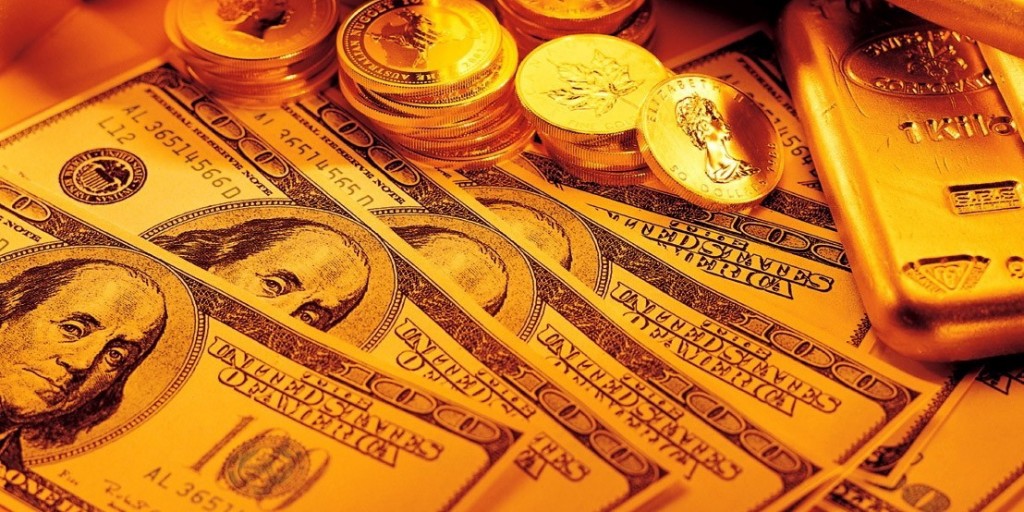One of the chief virtues of a gold standard is that it serves as a restraint on the growth of money and credit. It makes runaway government deficit spending and major monetary catastrophes such as hyperinflation practically impossible.
Opponents of a gold standard can’t defend the political malpractices that are enabled by a fiat currency regime. So instead they spin a narrative about how gold supposedly hampers the economy.
According to Keynesian economics, spending boosts the economy while savings contracts it.
Keynesians put the cart before the horse. Savings and investment drive the economic productivity that enable consumers to enjoy a high standard of living. But Keynesians believe the economy only booms when demand is artificially pumped up by debt, government spending programs, and perpetual currency depreciation (inflation) engineered by central bankers.
A gold standard produces deflation, its opponents charge, which incentivizes consumers to save money rather than spend it. Of course, what they call “deflation” is really just price stability. Over time, gold (and gold-backed money) maintains its purchasing power – neither gaining nor losing real value against other raw materials. When the U.S. pursued sound money policies from the post Civil War period into the early 1900s, consumer price levels were virtually flat; yet real economic growth soared. The Great Depression was caused not by gold but by a series of policy blunders from the recently established Federal Reserve.
The claim that people pull back on consumption when their currency retains value is a red herring. The real distinction between sound gold money and inflationary fiat money is that under a sound dollar, individuals (and governments) are less apt to take on large debt loads. The reason why debt is so alluring under an inflationary monetary system is that the real value of an existing debt gets eaten away over time.
When a currency is in the process of losing value, people are effectively taxed by holding it. So they deposit their cash into banks, hoping to earn enough interest to offset some of their inflation loss. Or they speculate on assets such as stocks which might (or might not) best inflation. Or they take out mortgages on houses, hoping home values will rise faster than their interest rate (and paying loan origination fees to banks for the privilege).
SILLY MYTH: “There’s Not Enough Gold Available Anymore to Back the Currency!”
Another, more recent, argument against reintroducing a gold standard is that there isn’t enough gold.
It’s true that there isn’t enough gold available at current prices to back all the dollars in circulation in the $18 trillion U.S. economy. But if gold were revalued at a significantly higher price, the supposed supply problem would be solved.
Put another way, gold is underpriced at $1,300/oz. According to monetary historian, economist, and gold advocate James Rickards, a more realistic gold price would be $10,000/oz. At that price, he argues, a gold standard would be feasible (based on a calculation of 40% of money supply divided by official gold holdings).
Other sound money advocates say that true 100% gold backing would require a gold price north of $20,000.
The idea that gold could be revalued to $10,000 – $20,000/oz might seem far-fetched to some. But it’s no less fundamentally justified than the Dow Jones at 10,000 – 20,000. Nor would a gold price equal to the Dow be unprecedented.
In fact, back in January 1980, the gold price spiked up to parity with the Dow. The Dow currently trades at close to 18,000. Were a new gold standard to be instituted today, $18,000 might be a sensible target price for gold.
This might be the best insurance against economic collapse (Ad)
Gold and Silver and a Freely Fluctuating Exchange Rate
Ideally, the free market would determine the appropriate price of gold and its status within the monetary system. Here is free-market economist Murray Rothbard’s take, from his book What Has Government Done to Our Money?:
What kind of ‘standard’ will a free money provide? The important thing is that the standard not be imposed by government decree. If left to itself, the market may establish gold as a single money (‘gold standard’), silver as a single money (‘silver standard’), or, perhaps most likely, both as moneys with freely fluctuating exchange rates (‘parallel standards’).
Silver is more practical than gold as a transactional currency among the masses due to gold’s steep value (even at current prices). For that same reason, gold is more practical than silver as a reserve asset for commercial banks and central banks.
Out of 92 basic elements, gold is one of only four that meet all the criteria for money. And by tradition, gold is the metal universally recognized as the ultimate money.
 A gold revaluation might be brought about by the free market through the emergency of competing private currencies. Or it could be spearheaded by a sound money movement in Congress, which is very much an uphill battle given politicians’ addiction to growing the debt.
A gold revaluation might be brought about by the free market through the emergency of competing private currencies. Or it could be spearheaded by a sound money movement in Congress, which is very much an uphill battle given politicians’ addiction to growing the debt.
Some sound money proponents are more optimistic about a gold-backed Chinese yuan. The Chinese are the world’s biggest gold producers and consumers, and the People’s Bank of China is rapidly ascending up the ranks of the world’s biggest gold reserves.
Official gold standard or not, the metal of kings will continue to serve its function as a universally recognized, inflation-proof money.
Stefan Gleason is President of the Sound Money Defense League, a national grassroots lobbying organization working to restore gold & silver to their historical role as America’s constitutional money. He also leads Money Metals Exchange, a national precious metals dealer with over 50,000 customers. Gleason has frequently appeared on national television networks such as CNN, FoxNews, & CNBC, & his writings have appeared in hundreds of publications such as the Wall Street Journal, TheStreet.com, Seeking Alpha, Detroit News, Washington Times, & National Review.


“….a gold standard is that it serves as a restraint on the growth of money and credit….”
HOW SO, Stefan ???
By magic ?
.
You can’t print gold.
So what ?!
Is this all the analysis you do ?
Why don’t we take Uranium instead ?
It’s much easier to control.
I’m all in with gold and silver – so hopefully – my 2 cents is that all states should be in control of the monetary printing and backing.
For instance silver certificates could be issued from the great state of Colorado.
As Ron Paul (more or less stated) anything can be used to back currency (even cannabis Ron?).
BTW: the curent banking system is nothing short of thievery tied in with the current tax schems.
SO it is with a ‘heavy heart’ that I say:
USURY is THEFT.
TAXATION is THEFT.
Is this why the last gold standard was run into the ground by the printing of too many of its paper representatives, much the same as the COMEX fraud operation today? The bankers, in 1971, instead of re valuing their gold backed reserve currency for obvious reasons, then switched to fiat for reasos I will try and explain later here. Now these same bankers have run fiat into the ground by….wait for it… printing too many fiat notes. Now another switch to a new reserve currency, most likely backed Again with gold, is in the offing. Probably SDRs, or why create a whole new currency with the trouble of getting it accepted when SDRs are already. With China, come September, in the SDR basket with her massive gold holdings (giving the Chinese apex elites a better seat at the table) and the who knows how large IMF and the BIS holdings (or what they can tap from other entities at their disposal – Vatican?) this looks as almost a certainty. With China’s CIPS inter banking service being rolled into the western SWIFT platform in the future this appears to be a done deal. The take away is that it is not what we use as money that counts but rather how it is created, as debt or debt free or ratio combination and by who in whose interests but more importantly if issued in the correct QUANTITY.
Here’s the deal. With each expansion of the bankers chosen Empire, as they experiment with viability ( 3rd Reich – Soviet Union- Anglo/American in the 20th century), there has been an equal expansion of the bankers debt system of money creation. When Empire inevitably reaches zenith and begins to implode, so does the bankers debt system in a direct correlation as new debt to pay off old debt reaches a zenith also. The Rothschild banking family has termed this phase the “Red Symphony”, as a large war is usually a by product. However, with each switch to the next issue of banker’s debt money they increase their stranglehold of control over all human structure on this planet by the very nature of them owning all the debts repayable. Now the bankers get to look around and see what assets they will foreclose on for that which cost them a trifle to produce, debt money. A recent example is the first western country to fall prey to this operation, Greece. The next time around whole nation states will be foreclosed upon, as in Greece. All this is part and parcel of the now re branded “New Universal Agenda”, coming out of the global warming meme, replacing the old NWO acronym. All the rest is noise with political and ideological diversions as the world economy struggles toward collapse under the bankers debt money system. Bankers know this cycle intimately as they are the ones creating this situation and use it in Hegelian dialectic, on many fronts and levels simultaneously,to advance their agenda to the next phase of “inventory and control” of everything and everyone on this planet. So all of us “traders” speculating that PMs will be the next great thing are most likely correct even if we don’t “see” the big picture of a world about to come under police state rule with the worse aspects of fascism and communism combined. all owned by the banking class, the .001%
There is another option, one neglected but preferable, called the multiple standard, which is as old as mono or bimetalism. It is a standard based on an average value of an index of commodities, from agriculture to mining to dry goods. It is not susceptible to being cornered or able to so easily disrupt an economy like a single commodity can. More importantly, it does not involve the uber cronyism like that of a gold standard that commits the singular greatest offense against Libertarian values by commissioning a single industry with the control of a nation’s currency. Also, under gold backing, asteroid mining would lead to a catastrophic impact. One good asteroid would provide more gold than has ever been mined in world history. Back in 1849, gold backing was a friend to the common man. No more. It has too many environmental and social externalities for us to gratuitously dig out of one hole and hide in another. Today, it will only empower the financial elite and hurt the working citizen.
The chief virtue of gold backed money is also its main problem. With a gold standard it is far to easy for wealthy interests to remove liquidity from the market and the result then is stagnation. But the biggest argument against the gold standard is that today more people than ever are very well off, and it was all done without gold.
GOLD at $10 K is no more ridiculous than printing a couple of Trillion dollars out of thin air, and then charging interest on said thin air!!!!